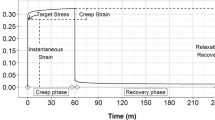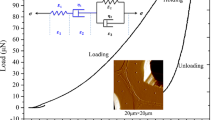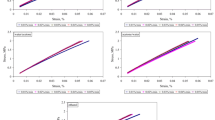Abstract
Viscoelasticity of air-dried or thermo-treated Cedrus deodara and Alnus cordata has been evaluated by means of Dynamic Mechanical Analysis (DMA) in the bending mode at 30 °C. E1, E2 and tanδ have been investigated by frequency-strain spectra. Mechanical properties have been explored by means of creep, stress-relaxation experiments and stress–strain plots at different strain-rates. Relaxation times and Young’s modulus E have been evaluated. The morphology of the samples has been examined by means of optical microscopy. Rheological differences either among air-dried woods, or between air-dried and thermo-treated woods, have been observed. In particular, air-dried wood (and especially Cedrus) shows a significant plastic behaviour. In contrast, the thermo-treatment makes the materials mainly elastic and structurally stable. The plasticity of the air-dried woods seems to be due to the shear of the hemicellulose interface and to plasticizers of lignin matrix; the increased elasticity of the thermo-treateds would be due to the additional lignin cross-linking, and loss of hemicellulose and plasticizers. Air-dried woods, especially the softwood, have a thermoplastic-like behaviour, where the non-bonded intermolecular interactions prevail, in contrast, the thermo-treated woods are thermosetting-like due to the higher degree of cross-link of the polymeric matrix. The study demonstrates the possibility of characterizing wood through viscoelasticity and dynamic mechanical analysis.








Similar content being viewed by others
References
Havimo M (2009) A literature-based study on the loss tangent of wood in connection with mechanical pulping. Wood Sci Technol 43:627
Stanciu MD, Curtu I, Grimberg R, Savin A (2013) Research regarding the complex modulus determined with dynamic mechanical analysis (DMA) in case of beech (Fagus Silvatica L.) and alder (Alnus Glutinosa Gaertn). Pro Ligno 9:587
Fabiyi JS, Ogunleye BM (2015) Mid-infrared spectroscopy and dynamic mechanical analysis of heat-treated obeche (Triplochiton scleroxylon) wood, Maderas. Ciencia y tecnología 17(1):5–16. doi:10.4067/S0718-221X2015005000001
Esteves BM, Pereira HM (2009) Wood modification by heat treatment: a review. BioResources 4:370
Heitner C, Dimmel D, Schmidt J (2010) Lignin and lignans: advances in chemistry. CRC Press, Boca Raton
Kelley SS, Rials TG, Glasser WG (1987) Relaxation behaviour of the amorphous components of wood. J Mater Sci 22:617
Olsson A, Salmén L (2004) The softening behavior of hemicelluloses related to moisture. In: Gatenholm P, Tenkanen M (eds) Hemicelluloses: science and technology. American Chemical Society, Washington, pp 184–197
Entwistle KM (2005) The mechanosorptive effect in Pinus radiate. D Don Holzforschung 59:552
Brémaud I, Ruelle J, Thibaut A, Thibaut B, Harris PJ (2013) Changes in viscoelastic vibrational properties between compression and normal wood: roles of microfibril angle and of lignin. Holzforschung 67:75
Sharma M, Brennan M, Chauhan SS, Entwistle KM, Altaner CM, Harris PJ (2015) Wood quality assessment of Pinus radiata (radiata pine) saplings by dynamic mechanical analysis. Wood Sci Technol 49:1239
Habibi MK, Tam LH, Lau D, Lu Y (2016) Viscoelastic damping behavior of structural bamboo material and its microstructural origins. Mech Mater 97:184
Fengel D, Wegener G (2003) Wood, chemistry, ultrastructure and reactions. Verlag, Berlin
Demaree LA, Erickson RW (1975) The temperature dependent effect of extractive content on redwood shrinkage. Sci. Jour. Ser. Paper No. 9096 of the Univ. of Minn. Agr. Exp. Sta.
Hakeem KR, Jawaid M, Alothman O (2015) Agricultural biomass based potential materials. Springer, Berlin
Lisperguer J, Droguett C, Ruf B (2009) Viscoelastic properties of Pinus Radiata acetylated wood. Wood Research 54:31
Obataya E, Umezawa T, Nakatsubo F, Norimoto M (1999) The effects of water soluble extractives on the acoustic properties of reed (Arundo donax L.). Holzforschung 53:63
Brémaud I, Amusant N, Minato K, Gril J, Thibaut B (2013) Effect of extractives on vibrational properties of African Padauk (Pterocarpus soyauxii Taub.). Wood Sci Technol 45:461
Wood Handbook (2010) Wood as an engineering material. Forest Products Society, Peachtree Corners
Birkinshaw C, Buggy M, Henn GG (1986) Dynamic mechanical analysis of wood. J Mater Sci Lett 5:898
Ravve A (2013) Principles of polymer chemistry. Springer Science & Business Media, Berlin
Ferrari S, Allegretti O, Cuccui I, Sandak J, Sandak A (2012) Thermo-vacuum process for wood thermal modification: results for some European softwood and hardwood species treated at different conditions, European Conference on Wood Modification
Tjeerdsma BF, Boonstra M, Pizzi A, Tekely P, Militz H (1998) Characterisation of thermally modified wood: molecular reasons for wood performance improvement. Holz als Roh- und Werkstoff 56:149
Nardi Berti R (2006) La struttura anatomica del legno e il riconoscimento dei legnami italiani di più corrente impiego. CNR-IVALSA, Firenze
Acknowledgments
We thank the anonymous referees for their precious suggestions.
Author information
Authors and Affiliations
Corresponding author
Ethics declarations
Conflict of interest
The authors declare that they have no conflict of interest.
Rights and permissions
About this article
Cite this article
Villani, V., Pucciariello, R. & Lavallata, V. Viscoelasticity of Air-Dried or Thermo-Treated Woods. J Polym Environ 25, 479–486 (2017). https://doi.org/10.1007/s10924-016-0809-0
Published:
Issue Date:
DOI: https://doi.org/10.1007/s10924-016-0809-0




